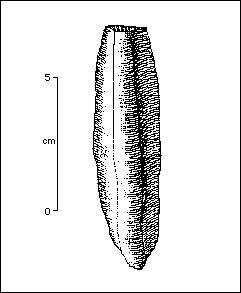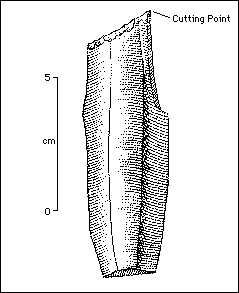 A Prismatic Blade
A Prismatic BladeAs you should know from your readings, the Upper Paleolithic was a period of incredible diversity and technological innovation. Lithic technology also underwent an important change during this time. The trend towards increasing the efficiency of stone tool production reached its pinnacle during this period with the development of Blade Technology and the tools that blade making made possible. In this section we will discuss two topics:
Few events in human prehistory rival the technological break-through inherent in the manufacture of prismatic blades. While using prepared core techniques such as the Disk Core and Levallois Core may have improved production efficiency by two-fold, blade technology improved it more than one hundred-fold! Provided that reasonably good raw materials were at hand, this new technology made it possible to manufacture large quantities of very sharp, straight cutting edges for use by themselves or as part of compound tools while using very little raw material. The blades, in turn, made it possible to manufacture such very useful implements as burins. These two tools, blades and burins, opened up a whole new world of wood and bone working with an ease and efficiency never previously matched.
 A Prismatic Blade
A Prismatic Blade
Note the relatively even, parallel sides, and the ridge providing strength in the cross-section. The material efficiency stems from the fact that because of their cross-section, blades could be made very thin and long. The narrower the blades were, the more blades that could be made from each core, with no loss in the amount of cutting edge.
As we mentioned in the introduction to blade technology, the ability to manufacture fairly uniform, thin blades opened up a whole new world of simple and complex tool for Upper Paleolithic peoples. One of the most important of these tools was the burin or micro-burin. Although we have examples of burins as far back as the middle deposits at Olduvai, it is only in the Upper Paleolithic that burins become the highly refined gouging and engraving tool that we typically think of when the term burin is used. The burin, in turn, allowed these peoples to manufacture another extremely important tool for life in the cold latitudes - the bone needle. Burins were used to gouge bone and antler in parallel tracks. The bone could then be split out in uniformly narrow blanks. The blanks then had an eye drilled into them, and were ground down to the proper diameter and sharpness. With this very important tool, fitted clothing for protection from the extreme cold could be made.
 Burin Made on a Blade
Burin Made on a Blade
The thin cross-section of the blade made the perfect platform for creating a tool with a very sharp but strong fine point. The angle of the snapped-off portion of the blade served to reinforce the burin for work engraving and gouging tough materials such as bone and antler.
|
|
|
|